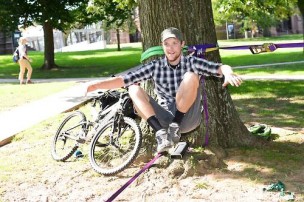At first glance, it was nearly impossible to pick Jesse Boyd and Kyle Newman out of the pack of students by Usdan. From their sportswear to their backpacks, Boyd and Newman dressed the part of college students—except, of course, for the yards of thick blue rope coiled in their arms.
I caught up with Boyd and Newman at the picnic tables outside Usdan after a University official had asked them to temporarily take down the slackline they had attached to trees in front of North College.
“They said they liked watching us, and that we could come back—just not today,” said Boyd, laughing. “There were dignitaries on campus, and they didn’t want us to get hurt or anything.”
For the unfamiliar, slacklining involves balancing on a narrow, flexible piece of webbing that is strung between two anchor points, usually two trees. The sight of students wobbling their way from one tree to another (or gracefully walking, if you have those kinds of skills) has become fairly common at the University lately, largely thanks to Boyd and Newman.
The two of them have a Facebook page, New England Slackers, which they update regularly with the location of their next adventure (Jackson Field, for example, or local parks) and hope to attract people interested in trying their hands—or feet—at the sport. Their first setup was outside North College because, as both slackers attested, the University has the best trees in the area.
“A decent amount of people have come by,” Boyd said. “I’d guess that 30 or 40 people came to look, and about half tried it out. Most of those people came back to try again the next time because they had so much fun. And then a lot of people just want to watch to see you fall.”
Boyd and Newman live in Middletown, just a few blocks off campus. Both work at EMPOWER, a local zip line company, and both were raised in Connecticut: Boyd grew up in Manchester and Newman is a native of Bristol.
Boyd walked his first line in college, while taking a yoga class that demanded completing yoga poses while balancing on the slackline.
“I sucked, so I decided to keep doing it,” Boyd said. “You get really good at falling.”
Newman agreed that building a solid foundation of skills on the line takes time and diligence. The slow progression, though, is ultimately gratifying.
“The process of getting to standing takes the longest,” Newman said. “Then you transition to walking. Doing poses—keeping your center of gravity when you’re not only focused on keeping your feet on the ground—is sort of the third and final progression.”
Although slackline groups on the West Coast abound (Boyd and Newman spoke about California’s Balance Committee, which posts where its members will be practicing and attracts followers, as well as Northwest Slackline, outside of Seattle), there are markedly fewer active slackers on the East Coast.
“There are adventurous people in New England, but they have no outlet for slacklining,” Newman said. “We decided to start an East Coast-based group to let people know what we’re doing.”
Boyd and Newman are eager to create an expanding slacklining network, and they hope to venture north into Vermont and New Hampshire.
“The demographic is definitely younger, and up-and-coming,” Newman said. “Lots of college kids are into it. I know there are other places around here with slacklining communities, so it would be great to unify them. Maybe we could even eventually invite the West Coast guys to hang out here.”
Boyd is especially excited about the possibility of slacklining over Wadsworth Falls, which is 50 feet in the air—a big step up from the two feet that separate slackers from the ground in routine practice. For their more dangerous feats, slackers use harnesses.
“You’ve got to have faith in your knowledge, and faith in your equipment,” Newman said. “It’s totally safe, but it’s scary when you fall for the first time and the leash catches you, and you’re swinging there.”
Both slackers laughed when asked to what extent their parents were in the loop, so to speak, about their more adventurous endeavors.
“When my mom saw the highline video, she yelled at me,” Boyd said.
A highline, Boyd explained, is a raised slackline, usually attached high up a tree’s trunk.
Newman noted an element of self-competition in slacking.
“I’m always trying to further what I can do,” he said.
The slackers also dream of one day stringing their line from the chimney of one building to that of another. Though the goal might be lofty, it is certainly possible.
“It’s all about redefining success,” Boyd said. “You go from your first time standing up, to standing for 10 seconds, to walking, to going 50 feet up in the air.”

Comments are closed